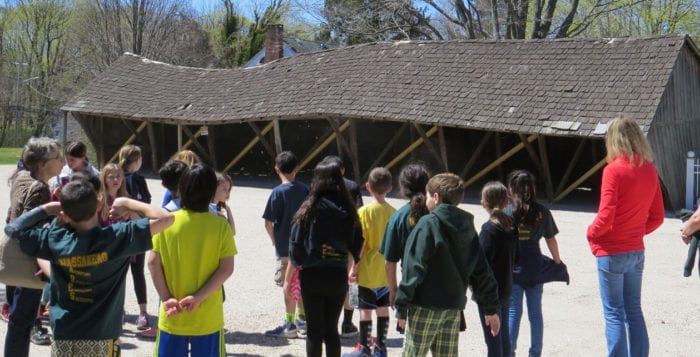By Beverly C. Tyler
Photographers have been taking pictures of the Caroline Church Carriage Shed in all seasons for many years. Since it was completed in the spring of 1887 at a cost of $273, this simple open building has aged gracefully, becoming more beautiful as the roof took on a natural wave shape that added to its special appeal. In addition, its utilitarian construction of white oak beams, white pine boards, cedar shingles and black locust posts allows us to see the construction methods that date back beyond when the shed was constructed, to the beginnings of our community when our homes, barns and out-buildings were built using these same local materials.
The shed’s seven bays for horses and carriages were funded by Mary Smith, Thomas Hodgkins, Margaret Dickenson and Sarah Dominick, General Francis Spinola, Shepard Jones, Mrs. Frank Norton and William Edwards, local residents who wanted shelter for their horses and carriages. A painted family name board was attached to the rear wall of each stall or bay.
In November of 1892, Thomas Hodgkins, who built the Emma Clark Library for the community in memory of his niece, wrote a note to library trustee Israel Tyler, “It has just occurred to me that my horse shed at the Episcopal Church may be of some use to yourself and family, and as I shall never again have any use for it, I hereby offer it to you as a free gift. Very Truly Yours, Thomas G. Hodgkins.”
Hodgkins died in December 1892 and is buried along the entrance walk in the Caroline Church graveyard. Israel Tyler’s name is still there on shed bay number three.
Barbara Russell, a member of the Caroline Church Historical Committee wrote, “What appears to some as a building that outgrew its original use about 100 years ago is … a rather unique parking place, the vehicles just changed. I always preferred it on rainy Sundays, as I could exit my car and open my umbrella without getting wet. In summer months, my car stayed cool in the shade. Those Victorians knew what they were doing when they planned and built a simple structure to make life a little more pleasant. The sliding windows on the west wall just gave the horses a little air and a view … Horses like to see what is going on around them.
“What does it look like to residents who travel Main Street or Dyke Road, and pass it everyday? What does it look like to a newcomer, maybe shopping for a home in Setauket? What does it look like to a child who sees it for the first time? To know the answers, you will have to ask your friends, your new neighbors, and the seven-year-old who lives down the street. But most important: What does it look like to you?
“Is it a humble structure that reminds you of a simpler life? Life may have been simple, but it wasn’t easy. We can rush through the morning, jump into the car and drive to church in a temperature-controlled car. In 1887, in addition to getting ourselves ready, we would have fed, groomed and harnessed the horse to our carriage. Then we made our way to church, rain or shine, hot or cold.”
In 1991, the church and cemetery, including the carriage shed, were listed on the National Register of Historic Places. The criteria include age, integrity and significance. The carriage shed, still in its original location, easily meets all of these.
In April, 2016, 450 fourth-grade students from the Three Village Central School District toured Setauket’s original settlement area including the carriage shed. They learned about the shed and about the horses and carriages that were a part of life here for more than 300 years. They also discovered that before the carriage shed was built, a colonial one-room schoolhouse stood on the site. From 1700, until a new school was built in the center of the Setauket Village Green in 1869, all of the children from Setauket, East Setauket and Drowned Meadow (now Port Jefferson) attended school here, including all the local children who later became members of the Revolutionary War Culper Spy Ring.
Tours of Caroline Church and the churchyard, as well as tours by the Three Village Historical Society include the historic Caroline Church Carriage Shed and speak to the many centuries when horses and carriages were essential to our lives.
Today the carriage shed needs extensive restoration. Caroline Church has hired an architect for plans to restore the shed to its original condition and has applied for grant funding to help offset the cost of restoration. “We believe the 1887 carriage shed, as the 1729 Caroline Church building, are historic parts of the Three Village community,” reported Don Muffly, senior warden at Caroline Church. “We need the community’s financial support as the cost of restoration is beyond the resources of the church alone.” If you can help, please send your tax deductible contribution to Save the Carriage Shed, C/O Caroline Church, 1 Dyke Road, Setauket, NY 11733. For further information call 631-941-4245.
Beverly Tyler is the Three Village Historical Society historian and author of books available from the Three Village Historical Society.







